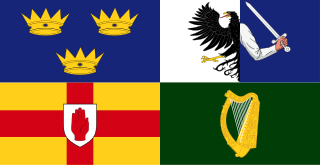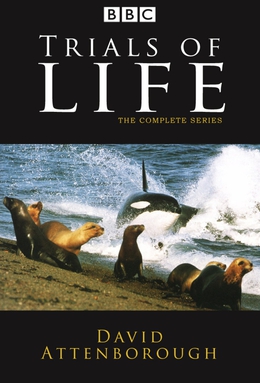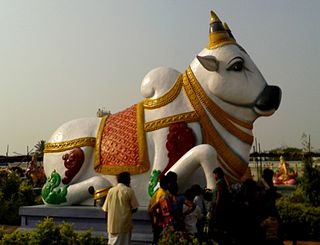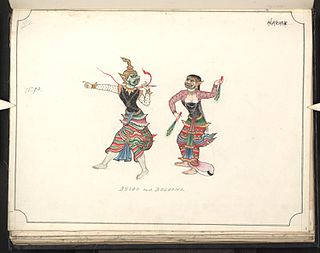Related Research Articles

A banshee is a female spirit in Irish folklore who heralds the death of a family member, usually by wailing, shrieking, or keening. Her name is connected to the mythologically important tumuli or "mounds" that dot the Irish countryside, which are known as síde in Old Irish.

Sedna is the goddess of the sea and marine animals in Inuit mythology, also known as the Mother of the Sea or Mistress of the Sea. Sedna is also known as Arnakuagsak or Arnaqquassaaq (Greenland) and Sassuma Arnaa and Nerrivik or Nuliajuk. She is sometimes known by other names by different Inuit groups such as Arnapkapfaaluk of the Copper Inuit from the Coronation Gulf area and Takánakapsâluk or Takannaaluk (Igloolik). In Killiniq, Labrador, she was referred to as "Old-woman-who-lived-in-the-sea". The story of Sedna, which is a creation myth, describes how she came to rule over Adlivun, the Inuit underworld.

In mythology, folklore and speculative fiction, shapeshifting is the ability to physically transform through an inherently superhuman ability, divine intervention, demonic manipulation, sorcery, spells or having inherited the ability. The idea of shapeshifting is in the oldest forms of totemism and shamanism, as well as the oldest existent literature and epic poems such as the Epic of Gilgamesh and the Iliad. The concept remains a common trope in modern fantasy, children's literature and popular culture.

The Trials of Life: A Natural History of Behaviour is a BBC nature documentary series written and presented by David Attenborough, first transmitted in the United Kingdom from 3 October 1990.

Animal worship is rituals involving animals, such as the glorification of animal deities or animal sacrifice. When a god is respected or worshipped by means of a representative animal, an animal cult is formed. Animal cults may be classified according to their outward form or according to their inward meaning, which may of course undergo transformations.

Book of Imaginary Beings was written by Jorge Luis Borges with Margarita Guerrero and published in 1957 under the original Spanish title Manual de zoología fantástica. It was expanded in 1967 and 1969 in Spain to the final El libro de los seres imaginarios. The English edition, created in collaboration with translator Norman Thomas di Giovanni, contains descriptions of 120 mythical beasts from folklore and literature.

Snowbird (Narya) is a fictional superhero appearing in American comic books published by Marvel Comics. Created by John Byrne, the character made her first appearance in Uncanny X-Men #120 (1979).

Philippine mythology is the body of stories and epics originating from, and part of, the indigenous Philippine folk religions, which include various ethnic faiths distinct from one another. Philippine mythology is incorporated from various sources, having similarities with Indonesian and Malay myths, as well as Hindu, Muslim, Shinto, Buddhist, and Christian traditions, such as the notion of heaven, hell, and the human soul. Philippine mythology attempts to explain the nature of the world through the lives and actions of heroes, deities, and mythological creatures. The majority of these myths were passed on through oral tradition, and preserved through the aid of community spiritual leaders or shamans and community elders.

In Hindu mythology, a kinnara is a paradigmatic lover, a celestial musician, part human, part horse and part bird. In Buddhist mythology, two of the most beloved mythological characters are the benevolent half-human, half-bird creatures known as the Kinnara and Kinnari, which are believed to come from the Himalayas and often watch over the well-being of humans in times of trouble or danger. Their character is clarified in the Adi Parva of the Mahabharata, where they say:
We are everlasting lover and beloved. We never separate. We are eternally husband and wife; never do we become mother and father. No offspring is seen in our lap. We are lover and beloved ever-embracing. In between us we do not permit any third creature demanding affection. Our life is a life of perpetual pleasures.

The each-uisge is a water spirit in Scottish folklore, known as the each-uisce in Ireland and cabyll-ushtey on the Isle of Man. It usually takes the form of a horse, and is similar to the kelpie but far more vicious.
Pedro Penduko is a Filipino comic book character styled as a folk hero or superhero, created by National Artist for Literature Francisco V. Coching and debuted on the magazine Liwayway.

Many references to ravens exist in world lore and literature. Most depictions allude to the appearance and behaviour of the wide-ranging common raven. Because of its black plumage, croaking call and diet of carrion, the raven is often associated with loss and ill omen. Yet its symbolism is complex. As a talking bird, the raven also represents prophecy and insight. Ravens in stories often act as psychopomps, connecting the material world with the world of spirits.
Really Wild Animals is a children's nature television series, hosted by Dudley Moore as Spin, an anthropomorphic globe. Comprising 26 episodes, the series aired between October 24, 1993 and March 2, 1998. The series was released on 13 VHS tapes, and later 13 DVDs. The creator and executive producer of Really Wild Animals was Andrew Carl Wilk. The series was nominated for five national Daytime Emmy Awards and won one.

Colombian folklore are beliefs, customs and cultural traditions in Colombia.
His Dark Materials is a trilogy of fantasy novels by Philip Pullman consisting of Northern Lights (1995), The Subtle Knife (1997), and The Amber Spyglass (2000). This is a list of the fictional races and creatures in the novels.

The Living Planet: A Portrait of the Earth is a BBC nature documentary series written and presented by David Attenborough, first transmitted in the UK from 19 January 1984.

Talking animals are a common theme in mythology and folk tales, as well as children's literature. Fictional talking animals often are anthropomorphic, possessing human-like qualities but appearing as a creature. The usage of talking animals enable storytellers to combine the basic characteristics of the animal with human behavior, to apply metaphor, and to entertain children.

A wide variety of mythical creatures are found in Burmese folklore and in mythology. Many Burmese creatures are part human or creatures capable of assuming human form. Most mythical creatures are endowed with humanistic mentalities, ability to converse with humans and also supernatural powers. During the 20th century, the role and diversity of Burmese mythical creatures were diversified by Shwe Thway comics which depicted the life of the Buddha, the Jataka tales and Burmese history.
References
- ↑ Monaghan, Patricia (1997). The New Book of Goddesses & Heroines. Llewellyn Publications. p. 324. ISBN 9781567184655.
- ↑ Eason, Cassandra (2008). Fabulous Creatures, Mythical Monsters, and Animal Power Symbols: A Handbook. Greenwood Publishing Group. pp. 2–3. ISBN 9780275994259 . Retrieved 4 June 2018.
Zonget, it is believed, appears to mortals in the form of a gray Arctic bird.
| | This article relating to a Siberian myth or legend is a stub. You can help Wikipedia by expanding it. |